Related Research Articles

The Silurian is a geologic period and system spanning 24.6 million years from the end of the Ordovician Period, at 443.8 million years ago (Mya), to the beginning of the Devonian Period, 419.2 Mya. The Silurian is the shortest period of the Paleozoic Era. As with other geologic periods, the rock beds that define the period's start and end are well identified, but the exact dates are uncertain by a few million years. The base of the Silurian is set at a series of major Ordovician–Silurian extinction events when up to 60% of marine genera were wiped out.

Gnathostomata are the jawed vertebrates. Gnathostome diversity comprises roughly 60,000 species, which accounts for 99% of all living vertebrates, including humans. In addition to opposing jaws, living gnathostomes have true teeth, paired appendages, the elastomeric protein of elastin, and a horizontal semicircular canal of the inner ear, along with physiological and cellular anatomical characters such as the myelin sheaths of neurons, and an adaptive immune system that has the discrete lymphoid organs of spleen and thymus, and uses V(D)J recombination to create antigen recognition sites, rather than using genetic recombination in the variable lymphocyte receptor gene.

The Sivalik Hills, also known as the Shivalik Hills and Churia Hills, are a mountain range of the outer Himalayas that stretches over about 2,400 km (1,500 mi) from the Indus River eastwards close to the Brahmaputra River, spanning the northern parts of the Indian subcontinent. It is 10–50 km (6.2–31.1 mi) wide with an average elevation of 1,500–2,000 m (4,900–6,600 ft). Between the Teesta and Raidāk Rivers in Assam is a gap of about 90 km (56 mi). The literal translation of "Sivalik" is 'tresses of Shiva'. Sivalik region is home to the Soanian archaeological culture. The hills are well known for their Neogene and Pleistocene aged vertebrate fossils.
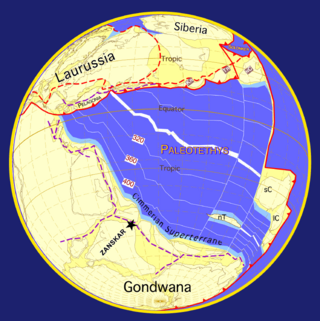
The geology of the Himalayas is a record of the most dramatic and visible creations of the immense mountain range formed by plate tectonic forces and sculpted by weathering and erosion. The Himalayas, which stretch over 2400 km between the Namcha Barwa syntaxis at the eastern end of the mountain range and the Nanga Parbat syntaxis at the western end, are the result of an ongoing orogeny — the collision of the continental crust of two tectonic plates, namely, the Indian Plate thrusting into the Eurasian Plate. The Himalaya-Tibet region supplies fresh water for more than one-fifth of the world population, and accounts for a quarter of the global sedimentary budget. Topographically, the belt has many superlatives: the highest rate of uplift, the highest relief, among the highest erosion rates at 2–12 mm/yr, the source of some of the greatest rivers and the highest concentration of glaciers outside of the polar regions. This last feature earned the Himalaya its name, originating from the Sanskrit for "the abode of the snow".

Birbal Sahni FRS was an Indian paleobotanist who studied the fossils of the Indian subcontinent. He also took an interest in geology and archaeology. He founded what is now the Birbal Sahni Institute of Palaeobotany at Lucknow in 1946. His major contributions were in the study of the fossil plants of India and in plant evolution. He was also involved in the establishment of Indian science education and served as the President of the National Academy of Sciences, India and as an Honorary President of the International Botanical Congress, Stockholm.

Darashaw Nosherwan Wadia FRS was a pioneering geologist in India and among the first Indian scientists to work in the Geological Survey of India. He is remembered for his work on the stratigraphy of the Himalayas. He helped establish geological studies and investigations in India, specifically at the Institute of Himalayan Geology, which was renamed in 1976 after him as the Wadia Institute of Himalayan Geology. His textbook on the Geology of India, first published in 1919, continues to be in use.
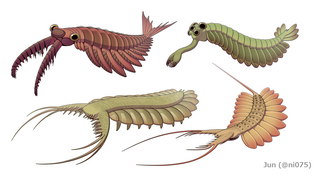
Dinocaridida is a proposed fossil taxon of basal arthropods that flourished in the Cambrian period with occasional Ordovician and Devonian records. Characterized by a pair of frontal appendages and series of body flaps, the name of Dinocaridids refers to the suggested role of some of these members as the largest marine predators of their time. Dinocaridids are occasionally referred to as the 'AOPK group' by some literatures, as the group compose of Radiodonta, Opabiniidae, and the "gilled lobopodians" Pambdelurion and Kerygmachelidae. It is most likely paraphyletic, with Kerygmachelidae and Pambdelurion more basal than the clade compose of Opabiniidae, Radiodonta and other arthropods.
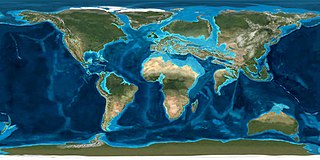
In the geologic timescale the Ypresian is the oldest age or lowest stratigraphic stage of the Eocene. It spans the time between 56 and47.8 Ma, is preceded by the Thanetian Age and is followed by the Eocene Lutetian Age. The Ypresian is consistent with the lower Eocene.
The Eifelian is the first of two faunal stages in the Middle Devonian Epoch. It lasted from 393.3 ± 1.2 million years ago to 387.7 ± 0.8 million years ago. It was preceded by the Emsian Stage and followed by the Givetian Stage.
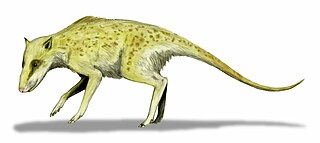
Indohyus is an extinct genus of digitigrade even-toed ungulates known from Eocene fossils in Asia. This small chevrotain-like animal found in the Himalayas is one of the earliest known non-cetacean ancestors of whales.

The Raoellidae, previously grouped within Helohyidae, are an extinct family of semiaquatic digitigrade artiodactyls in the clade Whippomorpha. Fossils of raoellids are found in Eocene strata of South and Southeast Asia.
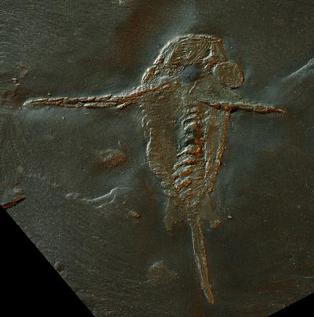
Schinderhannes bartelsi is a species of hurdiid radiodont (anomalocaridid) known from one specimen from the lower Devonian Hunsrück Slates. Its discovery was astonishing because previously, radiodonts were known only from exceptionally well-preserved fossil beds (Lagerstätten) from the Cambrian, 100 million years earlier.
Janusiscus schultzei is an extinct gnathostome vertebrate dating from the Early Devonian period in Siberia, approximately 415 million years ago. It may be the sister group of the last common ancestor of Chondrichthyes or Osteichthyes. This makes J. schultzei a sister species to all living jawed vertebrates. The species name is in honor of Hans-Peter Schultze; the genus named after Janus, the Roman god of duality.
Rafatazmia chitrakootensis the sole member of the genus Rafatazmia is a fossil species of filamentous alga described from dolomite obtained from the Vindhya ranges of central India. It is among the oldest known eukaryotic life forms and dates to about 1600 million years. The genus is named after Rafat Azmi, the Indian paleontologist who discovered other fossils in the same area.
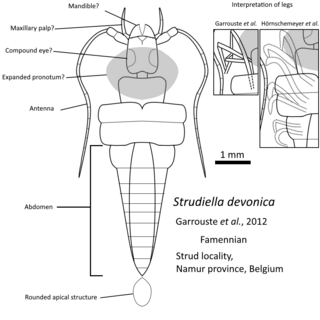
Strudiella devonica is a species of extinct arthropod from the Devonian. It was recovered in the Strud environment from the Bois des Mouches Formation, Upper Famennian. It was originally described as the first complete Late Devonian terrestrial insect, but due to its poor state of preservation, its affinity is discussed.
Compagopiscis is an extinct genus of placoderm known from the Gogo Formation. It lived in the Upper Devonian of Western Australia. The genus is monotypic, with its only species being Compagopiscis croucheri.
Professor Kate Trinajstic or Katherine M. Trinajstic is an Australian palaeontologist, evolutionary biologist, and winner of the Dorothy Hill Award. She is the Dean of Research, Faculty of Science and Engineering at Curtin University.

Sunil Bajpai is the Chair Professor of Vertebrate Paleontology in the Department of Earth Sciences, Indian Institute of Technology Roorkee. He is in service as a professor at IIT Roorkee since 1st January 1996 till September 2026. He also served as the director of the Birbal Sahni Institute of Palaeosciences from January 2013 to July 2018.
The Mandagery Sandstone is a Late Devonian geological formation in New South Wales, Australia. It is one of several famed Australian lagerstätten, with thousands of exceptional fish fossils found at a site near the town of Canowindra.
The Himalayan fossil hoax, or simply the Himalayan hoax, or technically the peripatetic fossils, is a case of scientific misconduct perpetrated by an Indian palaeontologist Vishwa Jit Gupta of Panjab University. Since his doctoral research in the 1960s and following the next two decades, Gupta worked on the geology and fossil record of the Himalayan region, producing hundreds of research publications that were taken as fundamentals to understanding the geological formation of the Himalayas. Australian geologist, John Talent from Macquarie University, had followed Gupta's research and happened to visit the Himalayas where he found that Gupta's fossils did not match the geological settings there. In 1987, in the presence of Gupta at a scientific conference in Canada, Talent publicly displayed that Gupta's fossils were identical to those found in Morocco. Talent and his student Glenn Brock made systematic reanalysis of Gupta's research bringing out the evidence that Gupta had manipulated, faked and plagiarised his data.
References
- ↑ Stevens, William K. (23 April 1989). "Scientist Accused of Faking Findings". The New York Times. ISSN 0362-4331 . Retrieved 27 December 2023.
- ↑ Chaman, Vishakha (28 October 2017). "Journal club for Panjab University researchers likely". The Times of India. ISSN 0971-8257 . Retrieved 28 December 2023.
- ↑ Bharti, Vishav (3 April 2016). "Layers of dust years after 'Himalayan fossil hoax'". The Tribune. Retrieved 27 December 2023.
- 1 2 3 "What happens to the Whistleblowers?". Australian Broadcasting Corporation. 3 September 2005. Archived from the original on 11 September 2005.
- 1 2 Ruffell, Alastair; Majury, Niall; Brooks, William E. (1 February 2012). "Geological fakes and frauds". Earth-Science Reviews. 111 (1): 224–231. doi:10.1016/j.earscirev.2011.12.001. ISSN 0012-8252.
- ↑ Waterhouse, J. B. (25 January 1990). "The peripatetic fossils: part 4". Nature. 343 (6256): 305–307. doi:10.1038/343305a0. ISSN 1476-4687.
- ↑ "Department of Geology Panjab University Chandigarh ਪੰਜਾਬ ਯੂਨੀਵਰਸਿਟੀ ਚੰਡੀਗੜ੍ਹ पंजाब विश्वविद्यालय चंडीगढ़ पंजाब यूनिवर्सिटी चंडीगढ़ Chandigarh India". geology.puchd.ac.in. Retrieved 28 December 2023.
- ↑ Sahni, M. R.; Gupta, V. J. (25 January 1964). "Graptolites in the Indian Sub-continent". Nature. 201 (4917): 385–386. doi:10.1038/201385b0. ISSN 1476-4687.
- ↑ Sahni, M. R.; Gupta, V. J. (1 December 1964). "Graptolites from the Kashmir Himalayas, also a Note on the Discovery of Fossils in the Muth Quartzite". Nature. 204 (4963): 1081–1082. doi:10.1038/2041081a0. ISSN 1476-4687.
- ↑ Sahni, M. R.; Gupta, V. J. (1964). "Lower Palaeozoic Fossils from the Kashmir Himalaya" (PDF). Current Science. 33 (13): 402–403. ISSN 0011-3891. JSTOR 24061792.
- ↑ Sahni, M. R.; Gupta, V. J. (1964). "Additional fossils from the lower palaeozoic of the Kashmir Himalaya" (PDF). Current Science. 33 (17): 527. ISSN 0011-3891.
- ↑ Sahni, M.R.; Gupta, V.J. (1964). "First record of fossils in the Muth Quartzite". Journal of the Palaeontological Society of India. 4: 33–34. ISSN 0552-9360.
- 1 2 Fuchs, G.; Gupta, V.J. (1971). "Palaeozoic stratigraphy of Kashmir, Kishtwar and Chamba (Panjab Himalayas)" (PDF). Verhandlungen der Geologischen Bundesanstalt. 1 (6): 68–97.
- ↑ "Contributions to the palaeontology and stratigraphy of the lower palaeozoics of parts of Baramula district Kashmir India". Shodhganga. 1972. Retrieved 28 December 2023.
- 1 2 3 4 5 Talent, John (1994). "Vishwa Jit Gupta's Fraudulent Enterprise: Unanticipated Finale talent 1994" (PDF). I.U.G.S. Subcommission on Devonian Stratigraphy Newsletter. 11: 68.
- ↑ Berry, William B. N.; Gupta, V. J. (1966). "Monograptids from the Kashmir Himalayas". Journal of Paleontology. 40 (6): 1338–1344. ISSN 0022-3360.
- ↑ Janvier, Philippe (1997). "In retrospect chosen by Philippe Janvier". Nature. 389 (6652): 688–688. doi: 10.1038/39519 . ISSN 1476-4687.
- ↑ Waterhouse, J. B.; Gupta, V. J. (1 September 1979). "Early Permian Fossils from Southern Tibet, Like Faunas from Peninsular India and Lesser Himalayas of Garhwal". Geological Society of India. 20 (9): 461–464. ISSN 0974-6889.
- ↑ Gupta, V. J.; Rhodes, F. H. T.; Austin, R. L. (30 October 1967). "Devonian Conodonts from Kashmir". Nature. 216 (5114): 468–469. doi:10.1038/216468a0. ISSN 1476-4687.
- ↑ Brookfield, M. E.; Gupta, V. J. (1988). "The Devonian of Northern Gondwanaland: A Himalayan Viewpoint and Terrane Analysis". Devonian of the World: Proceedings of the 2nd International Symposium on the Devonian System — Memoir 14. 1: 579–589.
- ↑ Kato, Makoto; Gupta, Vishwa Jit (1989). "Late Palaeozoic Corals from the Himalayas". Journal of the Faculty of Science, Hokkaido University. Series 4, Geology and mineralogy. 22 (3): 399–424. ISSN 0018-3474.
- ↑ Gaździcki, Andrzej; Gupta, V.J. (1981). "Triassic foraminifers Involutinidae from West Carpathians and Himalayas - its stratigraphic and paleobiogeographic implications" (PDF). Bulletin - Geological Society of India. 14 (2): 101–106.
- ↑ Gupta, V. J.; Erben, H. K. (1 June 1983). "A late devonian ammonoid faunula from himachal pradesh, india". Paläontologische Zeitschrift. 57 (1): 93–102. doi:10.1007/BF03031752.
- ↑ Budurov, K. J.; Gupta, V. J.; Kachroo, R. K. (1 August 1984). "Some Permian Conodonts from the Zewan Formation, Kashmir Himalaya". Geological Society of India. 25 (8): 533–536. ISSN 0974-6889.
- ↑ Stevens, William K. (23 April 1989). "Scientist Accused of Faking Findings". The New York Times. ISSN 0362-4331 . Retrieved 27 December 2023.
- ↑ Gupta, V. J.; Turner, Susan (1973). "Oldest Indian Fish". Geological Magazine. 110 (5): 483–484. doi: 10.1017/S001675680003627X . ISSN 1469-5081.
- 1 2 Talent, John A. (1989). "The case of the peripatetic fossils". Nature. 338 (6217): 613–615. doi:10.1038/338613a0.
- ↑ Kenyon, Clare (14 October 2022). "Scientific fraud, poor research and honest mistakes lead to thousands of retractions". Cosmos. Retrieved 27 December 2023.
- ↑ Jayaraman, K. S. (1 February 1991). "Gupta faces suspension". Nature. 349 (6311): 645–645. doi: 10.1038/349645a0 . ISSN 1476-4687.
- 1 2 "The fraud of the century". DownToEarth. 15 February 1994. Retrieved 28 December 2023.
- ↑ Patnaik, Pratap R. (2015). "Scientific Misconduct in India: Causes and Perpetuation". Science and Engineering Ethics. 22 (4): 1245–9. doi:10.1007/s11948-015-9677-6. PMID 26197864.
- ↑ "Books authored by Vishwa Jit Gupta". www.exoticindiaart.com. Retrieved 3 January 2024.
- ↑ "Books by Vishwa Jit Gupta". www.gettextbooks.com. Retrieved 3 January 2024.
- ↑ Ruffell, Alastair; Majury, Niall; Brooks, William E. (2012). "Geological fakes and frauds" (PDF). Earth-Science Reviews. 111 (1–2): 224–231. doi:10.1016/j.earscirev.2011.12.001.
- ↑ Webster, Gary D. (2016). "An evaluation of the V. J. Gupta echinoderm papers, 1971–1989". Journal of Paleontology. 65 (6): 1006–1008. doi:10.1017/S002233600003331X.
- ↑ Jit Gupta, Vishwa (1989). "The peripatetic fossils: Part 2". Nature. 341 (6237): 11–12. doi:10.1038/341011a0.
- ↑ Erben, H. K. (1989). "Statement concerning a paper on Devonian allegedly Himalayan ammonoids". Paläontologische Zeitschrift. 63 (3–4): 335. doi:10.1007/BF02989519.
- ↑ Hughes, Nigel C. (2016). "The Cambrian palaeontological record of the Indian subcontinent". Earth-Science Reviews. 159: 428–461. doi: 10.1016/j.earscirev.2016.06.004 .
- ↑ Waterhouse, J. B. (1990). "The peripatetic fossils: Part 4". Nature. 343 (6256): 305–307. doi:10.1038/343305a0.
- ↑ Talent, John A. (1990). "The peripatetic fossils: Part 5". Nature. 343 (6257): 405–406. doi:10.1038/343405a0.
- ↑ Talent, John A.; Brock, Glenn A.; Engelbretsen, Michael J.; Kato, Makato; Morante, Richard; Talent, Ross C. (1989). "Himalayan Palaeontologic Database Polluted by Recycling and Other Anomalies". Journal of the Geological Society of India. 34 (6).